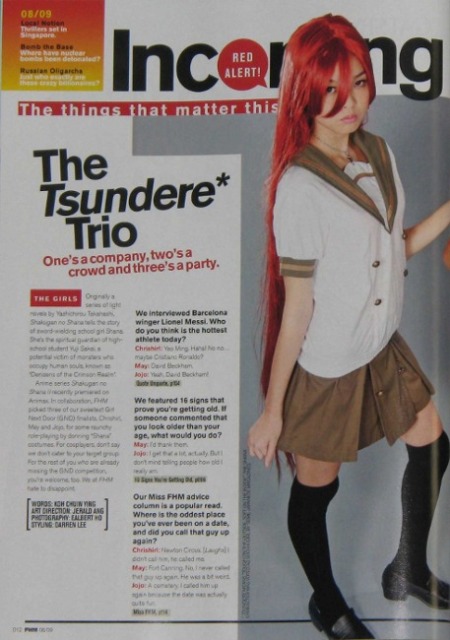Via Gordonator:
Proof that otaku culture has reached a certain level of saturation in your country? When something as abashedly mainstream as the “lad mag” FHM prominently uses the word “tsundere.”

(From the July 2009 issue of Singapore’s FHM)
Via Gordonator:
Proof that otaku culture has reached a certain level of saturation in your country? When something as abashedly mainstream as the “lad mag” FHM prominently uses the word “tsundere.”

(From the July 2009 issue of Singapore’s FHM)
To begin with the influential words of Hiroki Azuma:
“Today the claim that otaku-like sensibilities are unique to Japan no longer holds such force…I absolutely do not perceive the emergence of otaku culture as a uniquely Japanese phenomenon. Rather, I think that it should be grasped as one manifestation in Japan of a grand trend toward the postmodernization that began in the middle of the twentieth century. It is precisely this reason that otakus’ works transcend national boundaries to be well received around the world.”1
History has agreed with him. During the last 10 years, moe has gone far in the US. Terms like “doujinshi” or “tsundere,” once known only to a bilingual few, are now familiar parlance for the new generation of international fans. In the US, niche anime like Strike Witches and Clannad, once thought unmarketable, have secured not only DVD releases but respectable sales. Moe influences are beginning to seep into all levels of international culture, even ones where you’d least expect it. What’s more, we begin to see this international fanbase move from a passive consumption of Japanese products to an active, creative role. This new generation is boldly breaking cultural boundaries, manifesting a fervent drive towards postmodern utopia.
This blog shall chronicle that drive, focusing on the fascinating now and the even more fascinating future. A future that proves, “Otaku culture is a culture without borders.”
1 Azuma, Hiroki. Otaku: Japan’s Database Animals. (Minnesota: University of Minnesota Press, 2009) 10.